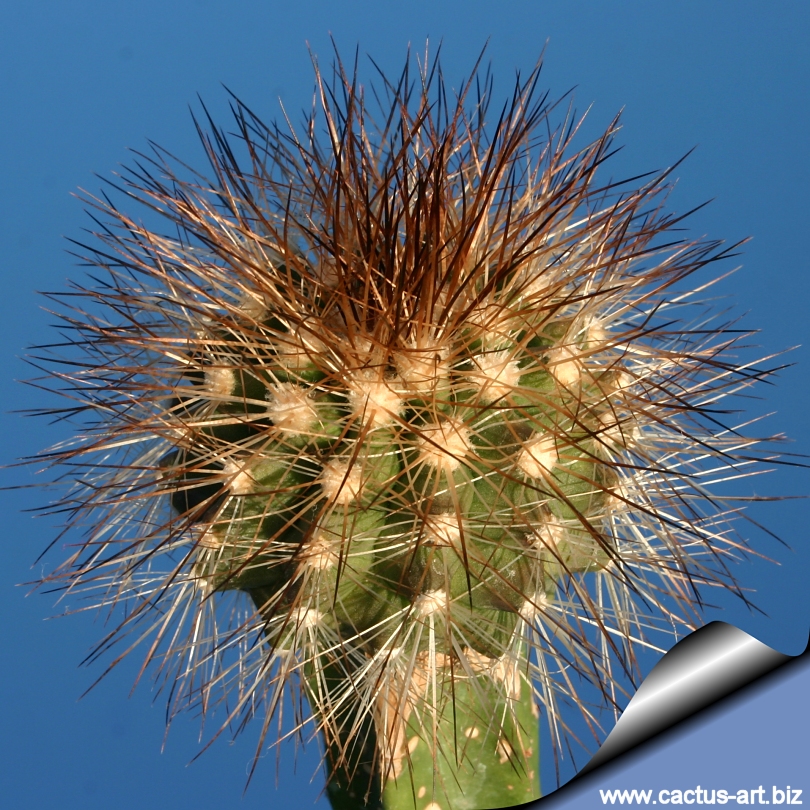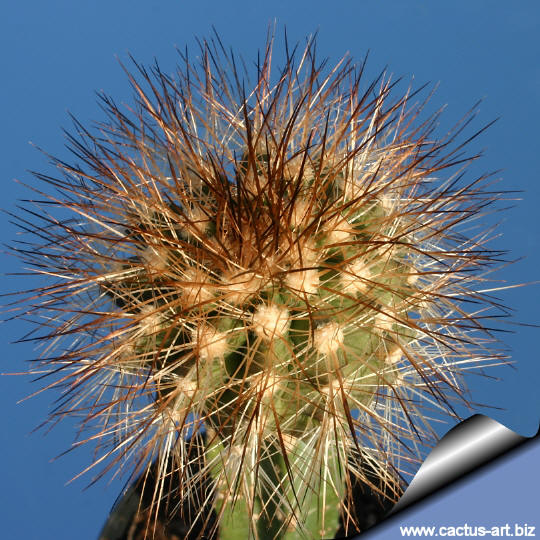|
|
|

C. krainziana forma brunispina is a striking slow growing species
that forms large clumps with age.
It is easily distinguished by long whiskery spines that vary in colour
(the 'brunispina' is the brownish coloured form). The globular body
freely offsets into a mound.
|
|
Description: Solitary or forming large clumps up to 1 m wide
densely covered by spines, it one of the more beautiful and popular
copiapoa, it is really the most extreme of a very variable population.
Stems: Globose to cylindrical usually grey to green in hue, up to
12 cm wide with a woolly crown.
Ribs: 13 to 24 ribs, straight.
Areoles: Large, roundish, with grey wool.
Spines: Variable, densely distributed, needle-like, long, very
thin, straight or curved, flexible usually white or greysh (or sometime
brownish in the so called forma 'brunispina')
Central spines: 14 to 20 up to 2,5 cm long (or more)
Radial spines: 10 to 12 greyish approx 2 cm long.
Flowers: Clear yellow, 3.5 cm long.
Fruit: White or rose, up to 1 cm long.
Remarks: Pretty,
white-spined forms need to be large before flowering; darker-spined
plants grow faster.
|
|
Cultivation: This
slow growing cactus is kept for the beauty of its form and spines.
It
must be protected from excessive heat and sun in
summer, and seems to do best in cultivation with a bit of shade.
It requires light but regular waterings in summer, but let the soil
mix dry between waterings, Prone to rot if over-watered.
Needs good drainage.
Keep warm and dry in
winter (10°C) to avoid rot. Not highly tolerant of a great deal
of frost. (Frost tolerance 0°C)
Propagation: Seeds (or
offsets if available), Grafting is often used to speed growth rate and
to create a back-up to plants in collection.
|
|


Advertising
|
|
|
|
|
|
Family:
Cactaceae (Cactus
Family)
Scientific name: Copiapoa
krainziana
F. Ritter 1963
forma brunispina
Origin:
Endemic to a very small area in Chile, II Region
Atacama desert,
Antofagasta, north of Taltal, coastal mountains, 500 - 2000 m. Typical
area is
San Ramon Valley.
Conservation status: Listed in
CITES appendix 2.
Habitat:
This species strives fully
exposed to the sun in extremely dry areas with very rare rainfall, on
hills and canyons on plains and on slopes facing north. They often grows
mingled with
clumps of Copiapoa cinerea
forma haseltoniana and columnar Eulychnia.
The dry season lasts 8 - 12 months and in some years it is possible to
have no rainfall at all. Rainfall less than 100 mm/year. The plants
obtain water mainly from condensation of coastal fog (camanchaca).
By the middle of the morning however, the fog cover dissipate and sun
breaking through the gaps warming the ground.
It is a member of the
Copiapoa cinerea
complex.
Synonyms:
-
Copiapoa cinerea v.
krainziana
(F.Ritter) G.J.Charles (1998)
-
Copiapoa cinerea ssp. Krainziana (F.Ritter) R.Slaba (1997)
Etymology: Named after Hans
Krainz, 1906-1980, director of the State Succulent Collection in
Zurich, Switzerland.
|
|
|
|

Photo of conspecific
taxa, varieties, forms and cultivars of
Copiapoa cinerea
complex. (This taxon has lots of synonyms (like most
copiapoa, with several controversial varieties and subspecies):
|
|